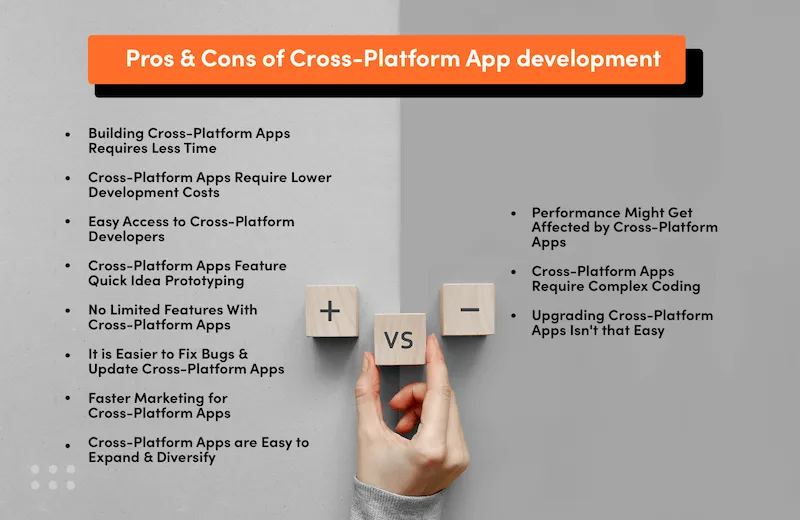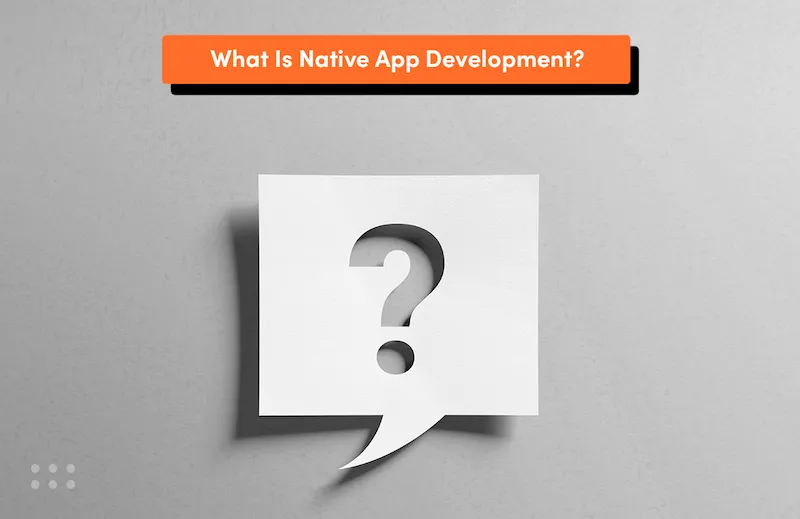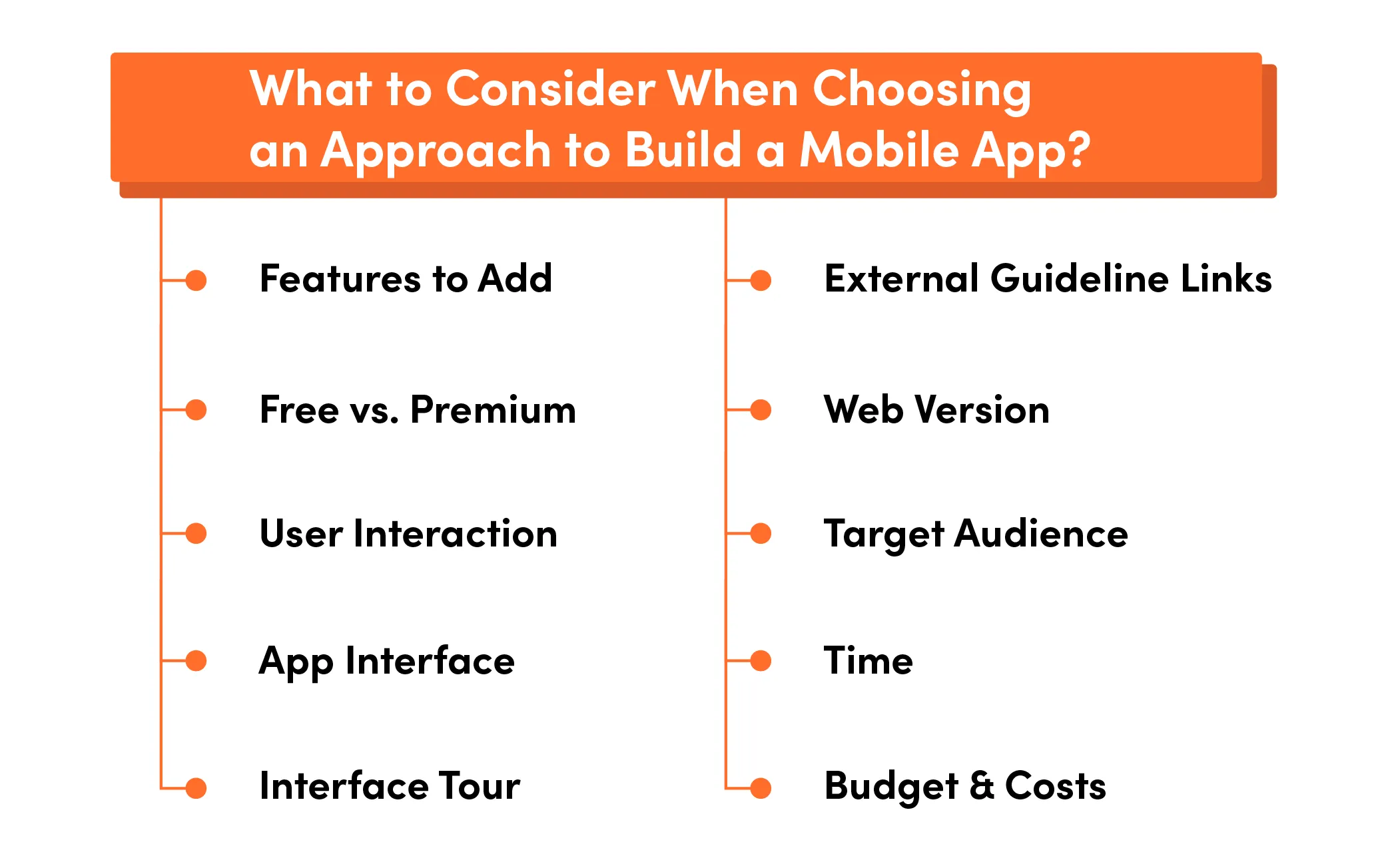Apps or mobile applications have become immensely popular in the recent decade. Stats reveal that more than 3.55 million apps are available on Google Play Store and 1.6 million on Apple's App Store.
With such high numbers, the global app market is expected to generate US$487.99 billion by the end of 2023. By 2026, the total revenue is predicted to expand by 9.27% annually (CAGR 2022-2026), with a market size of US$614.40 billion.
Nowadays, everyone has plenty of apps on their phone. Some of these apps are native, while others are cross-platform apps. The two approaches to developing apps are significantly different:
Cross-platform development means apps designed for multiple operating systems, like Android and iOS platforms. On the other hand, native development refers to building two different apps for separate operating systems.
Choosing between native app development and cross-platform is not easy. Both approaches offer clear benefits but come with certain risks. You should also know which approach would be best depending on app requirements.
So, in the following guide, we are going to cover everything about native vs. cross-platform development, including
- What is cross-platform native app development?
- Why is native mobile application development better?
- Is native development better than cross-platform?
Let's get started!
What Is Cross Platform App Development in Mobile Development?
Cross-platform app development refers to building apps for more than one platform using the same codebase. In other words, a cross-platform app would work for multiple operating systems without limiting its features.
React Native is one of the most popular cross platform frameworks.
Take WhatsApp, for example. Is a free cross-platform messaging app. You can send texts, share media, and make calls. It runs on Android and iOS.
Thus, building and maintaining a cross-platform app is easier because it saves you from creating two different codes for multiple OS. Because such an app would behave the same on both Android and iOS, it will be accessible to a large percentage of users. For instance, Instagram, Facebook, Walmart, and Bloomberg are all cross-platform apps with considerably high numbers of users.
Cross-platform apps save time and effort. They let developers build one experience instead of creating it many different ways. It saves much of a hassle for developers and makes the app versatile.
Besides the building part, deploying an app on all platforms at once makes marketing and managing straightforward - you don’t have to target platform users separately. It will also be quicker to remove bugs and update the app if it has the same codebase.
Another critical factor is the cost involved, as it will take a higher investment to build two native apps. Not to forget the costs involved in other areas like promotion and fixing common errors.
Cross-platform apps offer more benefits than managing two separate codebases. Maintaining many versions takes extra time and effort. It also increases the risk of bugs and update failures.
Pros & Cons of Cross Platform App Development and Cross Platform Frameworks

PROS: When Native vs Cross Platform Favors a Cross Platform Mobile Approach
First, let's go through some of the pros of cross-platform app development:
Building Cross Platform Apps Requires Less Development Time
A cross-platform app reuses the same code for multiple operating systems with slight changes. It saves considerably more time than creating two different codebases for various platforms.
Moreover, developing an app is more than writing its code. Factors like features, interface, and design also take significant time. You can create and test an MVP with a larger user base in much less time.
A native app requires almost double the development time. A cross-platform app, uses the least time to build.
Cross-Platform Apps Require Lower Development Costs
Using one codebase for both operating systems — Android and iOS — lowers development costs. It removes the need for two teams managing different apps on various platforms.
Marketing and updating the app in the future will also need money. Cross-platform mobile apps lower these costs because you advertise and update only once.
Easy Access to Cross Platform Developers (especially React Native)
Building a successful cross-platform app requires hiring professionals with advanced expertise. The good news is that finding developers for hybrid mobile apps is much easier, especially with React Native. It’s harder to find specialists who focus only on designing native apps.
Cross-Platform Apps Feature Quick Idea Prototyping
When building a cross-platform app, you can quickly prototype an idea and test it. It helps quickly judge an idea's weight or how it will work. You can also get constructive criticism and modify your idea appropriately.
Prototyping an idea is important because it serves as the foundation of your future goal app. Thus, when you put your concept to the test with your clients for a cross-platform app, you can meet expectations quicker than native apps.
No Limited Features With Cross-Platform Apps
Developers want every user to enjoy a smooth experience. That’s one reason cross-platform apps stand out. With one app interface and no separate codebases, users of different OS get the same features. This improves user experience and leads to better reviews and recommendations.
It is Easier to Fix Bugs & Update Cross-Platform Apps
Dealing with one codebase in cross-platform apps gives developers an advantage to quickly detect and fix bugs and errors in the app. It also saves you from the hassle of dealing with different, unexpected bugs in two native apps.
As you quickly detect and fix the bug, you can update your cross-platform app faster. It also gives you much room to listen to customers' reviews and modify your app quickly, which is harder if you are dealing with two codebases simultaneously.
Faster Marketing for Cross-Platform Apps
Advertising a cross-platform app frees you from targeting two different audiences. Because your app will work on Android and iOS, you can collectively target both operating systems' users, making marketing much easier and faster.
This is different from native apps. If you don’t develop two versions in perfect sync, you’ll end up marketing different apps to different audiences. It will take double the research, time, and effort to devise and run a business marketing strategy.
Read also: Mobile Software Development Trends To Know In 2023
CONS: Limitations and Performance Trade-Offs in Cross Platform Mobile Development
Such amazing benefits make cross-platform mobile apps an excellent approach for app development. However, there are some risks involved with cross-platforms, as listed below:
Performance Might Get Affected by Cross-Platform development
If not done correctly, performance is at the most risk in cross-platform apps. A universal solution for two systems often requires compromises. It can lead to heavier computational power consumption compared to native apps.
Cross-Platform Apps Require Complex Coding
Cross-platform mobile development requires advanced coding skills. Developers employ fluency in various technologies, such as JavaScript, React Native and a styling approach quite similar to building web apps, to create cross-platform mobile applications.
Upgrading Cross-Platform Apps Isn't that Easy
Besides developing, updating cross-platforms may be challenging. It can make or break your app's functionality, especially when fixing bugs and errors. When updating a native app, you can focus on one code offering features on a particular platform. However, cross-platform apps will require you to edit the codebase while considering compatibility with two different operating systems.
What is Native App Development?

One of the best ways to build applications is through native app development. Native app developers design for a single platform. This differs from cross-platform apps, which work on different mobile operating systems.
In other words, building native apps is a development process in which mobile applications are customized and committed solely to an Android or iOS platform.
Native apps provide a great user experience because they’re built for one platform. But a native development method takes more time and costs more. Each version for Android and iOS must be developed individually.
Native apps are preferred over cross-platform and hybrid app development because of their smart performance. They operate and load faster throughout the systems and have fewer bugs overall.
Hence, native apps are designed exclusively for a particular mobile platform. Developing an app with a specific platform (IOS or Android apps) allows developers to leverage all the possible options fully it provides without needing to make compromises for other types of gadgets.
Read also: Why Choose React Native For Your Mobile Tech Stack?
Pros & Cons of Native Development in the Native and Cross Platform Debate
Like cross-platform apps, native apps have benefits and a few demerits. Let's explore them!
PROS
The following are the top benefits of native apps:
Native Apps Have the Best Performance
When using native mobile app development, the application is designed and optimized for a specific platform. The native mobile apps are installed on the device, allowing the program to take full advantage of the smartphone's operating system. As a result, a native app is much more productive and offers higher performance.
Native Apps Feature Advanced Security
Creating a native mobile app is an effective way to ensure that your user's data is always secure. It's because native apps, compared to cross-platform applications, are less likely to face security threats.
First, native apps are not dependent on various web pages or programming platforms. Native apps also provide improved encryption technology and prevention.
Additionally, using programming languages specifically for a platform contributes to increased data security. It goes straight in contrast with cross-platform apps where the use of general languages raises the risk factors.
Native Apps Have Lower Risks of Bugs
Several factors ensure native apps have lower risks of bugs and errors. The app code, for example, operates directly on the operating system. Unlike hybrid apps, there is no independent software layer that can significantly slow down operations.
As a result, features such as the camera, GPS, and microphone can be used more quickly and effectively. Moreover, innovative games that have complicated 3D animation and visuals lend themselves better to native app development as they make use of the device's native graphics capabilities.

Native Apps Have More Visual Appeal
Native development apps are better than hybrid ones in visual appeal. Every aspect of native apps is designed with your operating system and uses every detail to maximize visual appeal.
Thus, these apps native to iOS or Android have their own visual appeals and features. For instance, if you own an iPhone, you've probably realized that many apps look completely different on your phone than on a friend's Android. Many are only accessible through OS-specific download facilities, such as Google Play, for Android users.
Native Apps Receive Fast Updates
Native applications can gain access to the most recent Android and iOS updates. However, programmers must wait for dependent tools to introduce various features for hybrid apps. As a result, hybrid app users cannot immediately access the most recent updates.
Native Apps Offer Better User Experience
Native apps offer a significantly more pleasant user experience than cross-platform apps with poor performance and a lack of offline functionality.
Moreover, a native app can utilize the platform's native UI and UX components. It's also simpler to optimize the screen resolution, dimensions, and pixel density of the native app UI.
Besides, native app platforms such as Android Studio or XCode frequently include ready-made templates to help reduce errors. So, in conclusion, native apps can mimic the appearance and feel of iOS platforms, offering an easy route to good UX.
CONS
Native apps have many benefits over cross-platform apps. However, as good as they are, native apps also come with some risks, as discussed below:
Native Apps Require More Efforts
Reaching as many customers as possible should be a priority if you want to sell a product. Such a well-known economic principle, when applied in native app development, may not be the best solution.
As mentioned earlier, if you'd like your device to be a native operating system while also being available on various platforms, you'll need to create two separate programs.
Thus, you must create multiple code bases for each OS. This usually requires the formation of separate teams with specialized knowledge. Each group will go through the same stages as the other, requiring more effort to make both apps similar.
Higher Costs Involved With Native Apps
Another significant disadvantage of native apps is that they require an evenly costly recovery phase, increasing the overall development costs.
Many developers overlook that software costs continue once the app is released. Besides, even though most of the work is completed during the app's maintenance stage, maintaining and updating numerous native apps is even more expensive.
Because of this, cross-platform apps are less likely to encounter this issue. They can be easily modified once-and-for-all because of their same codebase for different mobile operating systems.
Developing Native Apps is Time Consuming
Programs designed for a specific operating system perform better. However, this requires a great amount of time for each project's phases. As a result, if you're developing operating system software for each device, it'll take approximately twice as long.
Because of this, native development may not be the best option for your app. Hence, it is important to investigate thoroughly before selecting native development. Otherwise, a wrong decision can result in massive failures and even economic collapse.
Try our developers.
Free for 2 weeks.
No risk. Just results. Get a feel for our process, speed, and quality — work with our developers for a trial sprint and see why global companies choose Selleo.
Which One to Choose for Your Next Project?
Before discussing which one is best (native app development vs. cross-platform, it is important to know what they have to offer.
Cross-platform development is creating an app that works across multiple platforms. It allows you to write code once and reuse it across multiple platforms.
On the other hand, native app development creates a different app for each operating system. Though it might take more time and effort, native apps are more secure and fast and feature a higher user experience.
Still, the conflict between native apps and cross-platform app development has caused much confusion in the app development niche. So, let's find out when you should choose a native or cross-platform app for your next project!

When to Choose a Native App?
Native apps are an excellent choice for business owners who want to build a comprehensive app. Because they can use all the smartphone's characteristics, they are perfect for creating complex high-end apps.
However, native apps take longer to develop and are more expensive. So, if you're not rushing to release your app as a company owner, you should consider native app development.
Moreover, native apps are an investment for a lengthy period. They have chances to become more popular because they offer a better experience for users. In the end, native apps can also pay off handsomely if you have a particular audience you want to engage with.
When to Choose Cross-Platform App Development?
Higher deliverability becomes a priority if you provide services that require many customers daily. To ensure that your customers are getting all they require on time, cross-platform development is the best approach.
Cross-platform programs are simple to use. They offer the same features on multiple mobile platforms, which makes them a better option for a small company looking for optimum benefits with low investments.
Besides, cross-platform development is simpler to build and maintain. This makes it a better alternative if you are an IT business owner with restricted time to dedicate to app publicity.
What to Consider When Choosing an Approach to Build a Mobile App?

Once you decide which approach to choose for building your app (native app development vs. cross-platform), the next step is to simplify your idea. You can start by considering answering the following questions:
- Features to Add: What features or services do you want to provide through your app? What will be your app's best features to market later?
- Free vs. Premium: Are you planning on developing an app with free services? Or will there be a premium version with advanced features for enhanced user experience?
- User Interaction: How much user interaction do you want in your app? Should users be able to input, modify, erase, display, or share data in your app?
- App Interface: How do you want to design your app's interface? Remember, the first impression is important; a simple interface with prominent buttons will enhance the user experience. However, you can also consider other ways to customize your app's interface, like complex or animated.
- Interface Tour: Do you want your app's interface to interact with users and guide them through the basic features of the app?
- External Guideline Links: Will your app be easy or complex to understand and use? If it is complex, do you plan on creating external links to your app for guideline blogs or common FAQs?
- Web Version: Will you look forward to diversifying your app with a web version? This factor applies to both native and cross-platform apps, as you can always build a web version of your app in parallel to the mobile app.
- Target Audience: Have you finalized your target audience? How would you classify your target users (like through their age, usage, or like geographic, demographic, psychographic, and behavioral factors)?
- Time: How much time is needed to develop one cross-platform or two native apps? When do you plan on releasing or marketing your app?
- Budget & Costs: Do you have enough budget to fund your app development needs? Not to forget hiring development teams and marketing expenses afterward. You should also consider the management and upgrading costs involved.
Once you answer all these, you'll have the basics of your app and business strategy ready!
Read Also: How To Choose A Mobile App Development Company
Summary: Comparing Native and Cross Platform Approaches in Mobile App Development
In a nutshell, the primary difference between a native and cross-platform development app is the intended operating system. A native app is designed for a particular OS, such as Android or iOS, while cross-platform apps can work on more than one system.
While the native app has one fixed code base for each OS, it is more appropriate for a long-term release. Similarly, cross-platform apps have one codebase that works for different operating systems. They are more suitable if you are facing time restrictions for app release.
Security, performance, and scalability are three important factors when building an app. It should be able to deliver the best experience to its users with frequent updates and backups.
Such an excellent user experience is only possible when developing teams are highly skilled. If you are looking for such experts, React Native can be your ultimate solution!
React Native is a JavaScript framework aimed at creating natively rendered cross-platform mobile applications for iOS and Android.
With more than 230+ tech leaders and a long list of successfully designed applications, you are welcome to explore the following benefits of React Native:
- high performance
- modularity & stability
- easy debugging
- time savings
- cross-platform development
- personalized UX
- one team dedicated to multiple platforms
- native look and visuals of your apps
Sounds exciting, right? Feel free to reach out and our developers team will be happy to assist you!
Native mobile app development means building separate apps for each platform. For example, iOS apps use Swift or Objective-C. Native Android apps use Kotlin or Java. Each version is tuned for its platform and gives users the best experience on mobile devices. In contrast, cross-platform app development uses a single codebase. It runs on different platforms such as Android, iOS, and web browsers. This method helps development teams build faster while keeping shared logic.
The biggest benefit of native mobile development is performance. It gives full access to native features such as GPS, camera, sensors, and offline storage. Native apps connect directly with the operating system. This allows development teams to deliver smooth user experiences across mobile devices. They work best for high-performance cases like gaming, banking, or intelligent fraud detection, where speed and system-level access are critical.
Native mobile app development usually requires different app versions for iOS and Android. That means separate development teams, technologies, and maintenance cycles. This setup increases costs and extends delivery time. If you want to launch quickly on different platforms, native apps can slow your roadmap. Updates, QA, and publishing happen separately for iOS apps and native Android apps.
Cross-platform apps are quick and affordable to build. A single codebase runs smoothly across mobile devices and different platforms. This lowers cost, speeds up delivery, and simplifies bug fixing. It’s perfect for startups, MVPs, and teams building for both web browsers and mobile users.
Frameworks like React Native and Flutter have improved a lot. Still, cross-platform apps can face limits in native features and performance. This is especially true for AR, 3D graphics, or push notifications. A single codebase helps with maintenance but can cause UI or speed differences on mobile devices, especially in native Android apps and iOS apps.›
Your choice depends on the project’s priorities:
- Choose native mobile development if you need high performance and full access to native features. It works best for apps that use advanced functions such as intelligent fraud detection or secure payments.
- Choose cross-platform if you want to reach users on different platforms faster and on a smaller budget. One development team can manage a single codebase for all versions.
Both methods connect easily with APIs, web browsers, and backend systems.
The best option depends on your scope, timeline, and target audience.
React Native lets developers write in JavaScript or TypeScript. It ships apps that feel like native Android apps and iOS apps. It exposes native features—camera, sensors, push notifications - via simple bridges. Development teams can manage different app versions from a single codebase. For mobile devices and web browsers, React Native balances speed, quality, and cost.





